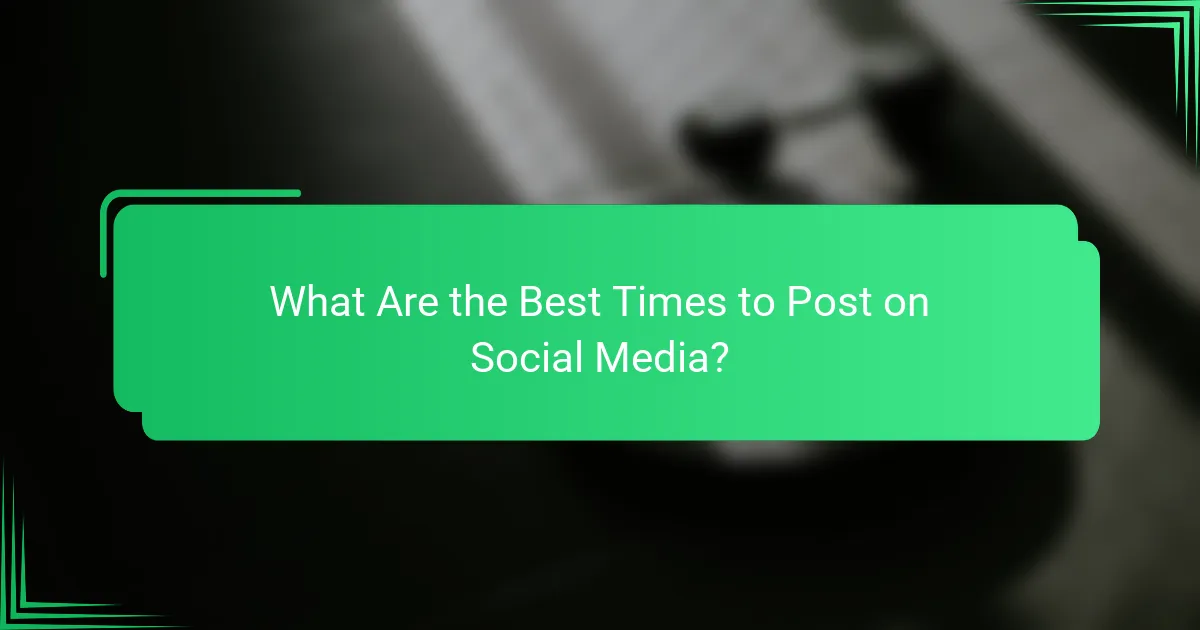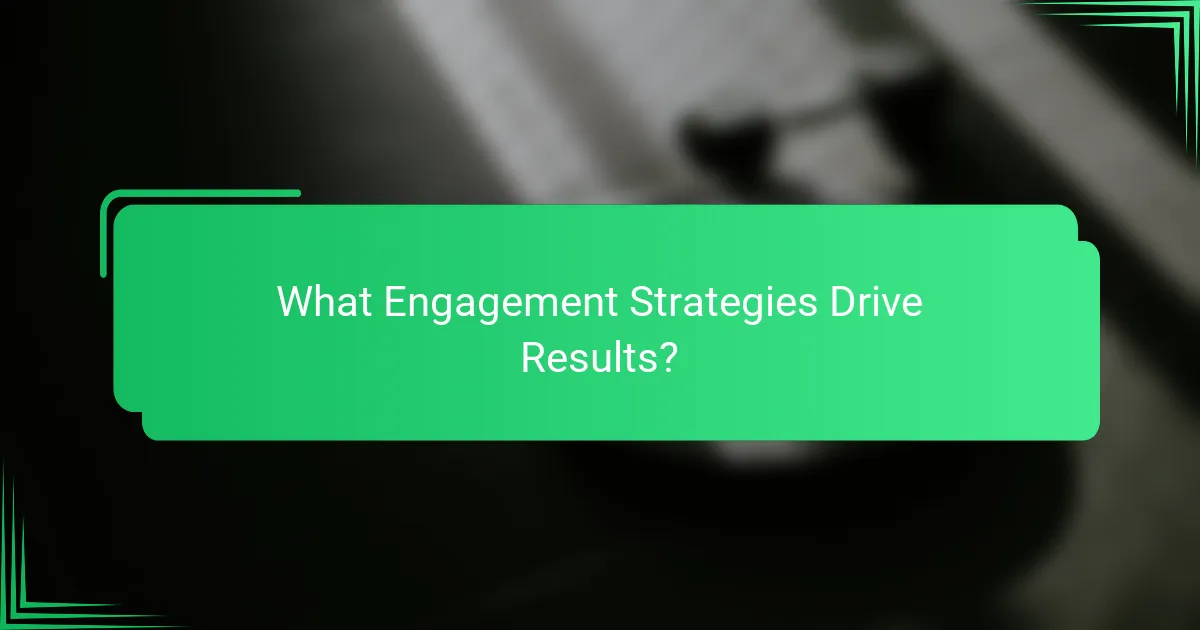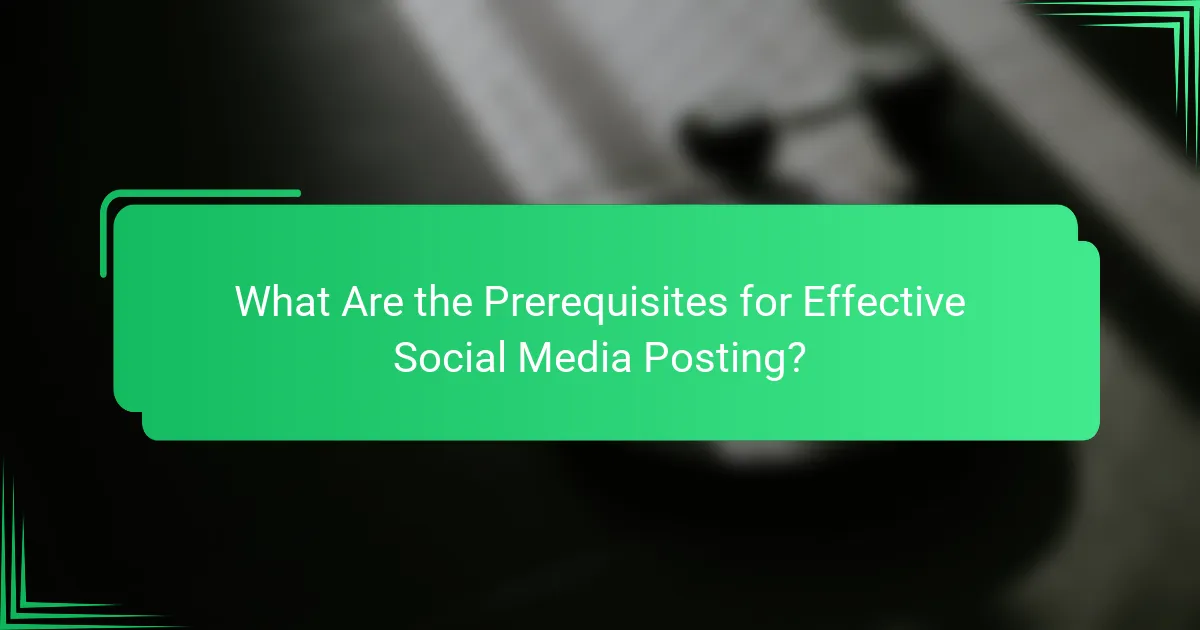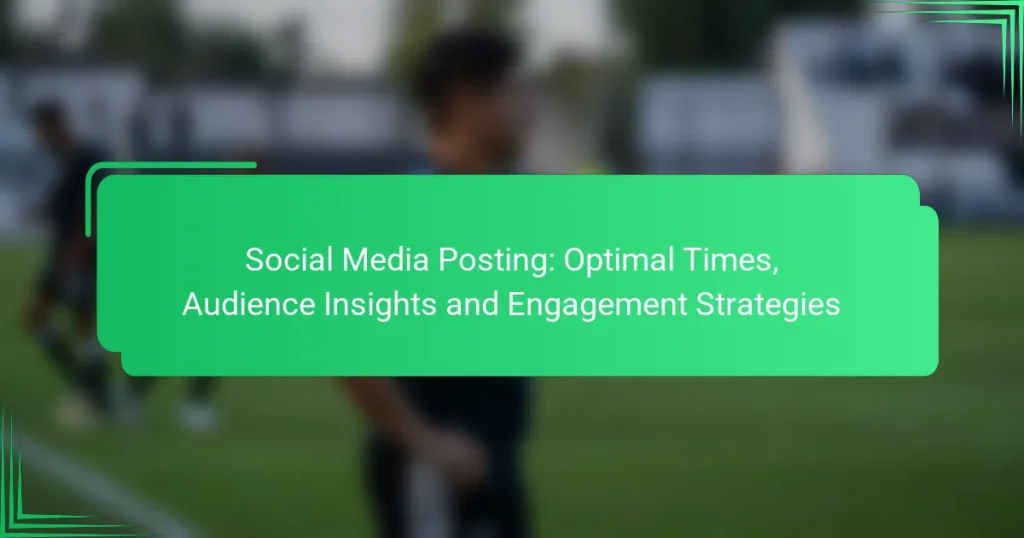To maximize your social media impact, it’s crucial to identify the optimal times for posting, which often fall on weekdays during mid-morning to early afternoon. By leveraging audience insights, you can tailor your content to better resonate with your target demographic, enhancing engagement. Additionally, implementing effective engagement strategies, such as interactive content and influencer collaborations, can significantly boost audience interaction and drive desired outcomes.

What Are the Best Times to Post on Social Media?
The best times to post on social media vary by platform and audience, but generally, weekdays during mid-morning to early afternoon tend to yield higher engagement. Understanding peak engagement hours, day-specific trends, and platform-specific timings can help optimize your posting strategy.
Peak engagement hours
Peak engagement hours refer to the times when your audience is most active on social media. Typically, this falls between 10 AM and 2 PM on weekdays, with spikes around lunch hours. Monitoring your specific audience’s activity can help refine these hours further.
Tools like social media analytics can provide insights into when your followers are online. Aim to schedule posts during these peak times to maximize visibility and interaction.
Day-specific trends
Different days of the week can show varying engagement levels. For instance, posts made on Wednesdays and Thursdays often perform better than those on Mondays or Fridays. Understanding these trends can help you tailor your posting schedule accordingly.
Consider running tests to determine which days yield the best results for your specific audience. Adjust your strategy based on the data you collect over time.
Platform-specific timings
Each social media platform has its own optimal posting times. For example, Instagram and Facebook generally see higher engagement during weekdays, while Twitter may peak during events or trending topics. Knowing these specifics can enhance your reach.
Utilize platform analytics to identify when your posts receive the most interaction. This allows you to fine-tune your posting strategy for each social media channel.
Time zone considerations
Time zone differences can significantly impact your posting strategy, especially if your audience is global. Ensure you account for the time zones of your primary audience when scheduling posts.
Using scheduling tools that allow you to set posts according to your audience’s local time can help maintain engagement across different regions.
Seasonal variations
Seasonal changes can influence social media engagement, with certain times of the year seeing spikes due to holidays or events. For example, engagement might rise during the holiday season or special events relevant to your audience.
Stay aware of these seasonal trends and adjust your content and posting times to align with periods of increased activity. This can help you capture more engagement during peak seasons.

How Can Audience Insights Improve Engagement?
Audience insights can significantly enhance engagement by tailoring content to the preferences and behaviors of your target demographic. By understanding who your audience is and how they interact with your posts, you can create more relevant and appealing content that resonates with them.
Demographic analysis
Demographic analysis involves examining the characteristics of your audience, such as age, gender, location, and income level. This information helps you identify which segments are most engaged with your content and allows for targeted messaging. For instance, if your audience skews younger, platforms like Instagram or TikTok may be more effective for your campaigns.
Utilizing tools like Google Analytics or social media insights can provide a clearer picture of your audience demographics. Regularly updating this data ensures your strategies remain relevant as audience trends shift.
Behavioral patterns
Understanding behavioral patterns entails analyzing how your audience interacts with your content over time. This includes tracking engagement metrics such as likes, shares, comments, and click-through rates. By identifying peak engagement times and preferred content types, you can optimize your posting schedule and content strategy.
For example, if your audience tends to engage more during weekday evenings, consider scheduling posts during those times to maximize visibility. Monitoring these patterns regularly can help you adapt to changing audience behaviors.
Content preferences
Content preferences refer to the types of content your audience enjoys, such as videos, infographics, or blog posts. By assessing which formats receive the most engagement, you can focus your efforts on creating similar content. Surveys and polls can be effective tools for directly asking your audience about their preferences.
For instance, if your audience shows a strong preference for video content, investing in high-quality video production may yield better engagement results. Experimenting with different formats and analyzing the outcomes can help refine your content strategy.
Feedback mechanisms
Feedback mechanisms are essential for gathering insights directly from your audience. This can include comments on posts, direct messages, or structured feedback through surveys. Actively encouraging feedback helps you understand audience sentiments and areas for improvement.
Implementing regular check-ins, such as quarterly surveys, can provide valuable insights into audience satisfaction and expectations. Responding to feedback not only improves your content but also fosters a sense of community and loyalty among your followers.

What Engagement Strategies Drive Results?
Effective engagement strategies are essential for maximizing audience interaction and achieving desired outcomes on social media. These strategies include utilizing interactive content, collaborating with influencers, crafting compelling calls-to-action, and leveraging content scheduling tools.
Interactive content types
Interactive content types, such as polls, quizzes, and contests, significantly enhance user engagement. These formats encourage participation and can lead to higher sharing rates, as users are more likely to share content that they actively engage with.
Consider incorporating various interactive elements into your posts. For example, a simple poll about a trending topic can spark discussions and increase visibility. Aim to create content that invites responses and fosters community interaction.
Influencer collaborations
Collaborating with influencers can amplify your reach and credibility. Influencers often have established trust with their audiences, making their endorsements more impactful than traditional advertising.
When selecting influencers, consider their relevance to your brand and audience. Micro-influencers, who typically have smaller but highly engaged followings, can be particularly effective for niche markets. Establish clear objectives for the collaboration to ensure alignment and maximize results.
Call-to-action effectiveness
Strong calls-to-action (CTAs) are crucial for guiding audience behavior and driving engagement. A well-crafted CTA prompts users to take specific actions, such as liking, sharing, or visiting a website.
To enhance CTA effectiveness, use clear and concise language. Phrases like “Join the conversation” or “Get your free trial” can motivate users to act. Test different CTAs to see which resonates best with your audience and adjust accordingly.
Content scheduling tools
Content scheduling tools streamline the posting process and help maintain a consistent presence on social media. These tools allow you to plan and automate posts, ensuring that your content reaches audiences at optimal times.
Popular scheduling tools include Hootsuite, Buffer, and Later. When choosing a tool, consider features like analytics, user interface, and integration with other platforms. Regularly review performance metrics to refine your posting strategy and improve engagement rates.

How to Analyze Social Media Performance?
Analyzing social media performance involves evaluating metrics that reflect audience engagement and content effectiveness. By focusing on key performance indicators (KPIs) and utilizing analytics tools, you can gain insights that drive strategy adjustments and improve overall results.
Key performance indicators
Key performance indicators (KPIs) are essential metrics that help measure the success of your social media efforts. Common KPIs include engagement rate, reach, impressions, and conversion rate. These metrics provide insights into how well your content resonates with your audience.
For example, a high engagement rate indicates that your audience is interacting with your posts, while a low conversion rate might suggest that your call-to-action needs improvement. Regularly tracking these KPIs allows you to identify trends and make informed decisions.
Analytics tools comparison
There are various analytics tools available for tracking social media performance, each offering unique features. Popular options include Google Analytics, Hootsuite, and Sprout Social. Google Analytics excels in website traffic analysis, while Hootsuite provides a comprehensive view of multiple platforms in one dashboard.
When choosing a tool, consider factors such as ease of use, the specific metrics you want to track, and your budget. Many tools offer free trials, allowing you to test their capabilities before committing.
Reporting best practices
Effective reporting is crucial for understanding social media performance and communicating results to stakeholders. Start by defining your reporting goals and the KPIs that align with those objectives. This ensures that your reports focus on what matters most.
Use visual aids like charts and graphs to present data clearly and concisely. Regularly scheduled reports, whether weekly or monthly, help track progress over time. Additionally, include actionable insights and recommendations based on the data to guide future strategies.

What Are the Prerequisites for Effective Social Media Posting?
Effective social media posting requires a clear understanding of your target audience and well-defined objectives. These prerequisites ensure that your content resonates with viewers and achieves desired outcomes.
Understanding target audience
Knowing your target audience is crucial for crafting relevant content. This involves identifying demographics such as age, gender, location, and interests. For instance, a brand targeting young adults may focus on platforms like Instagram or TikTok, while a business aimed at professionals might prioritize LinkedIn.
Utilize analytics tools to gather insights about your audience’s behavior and preferences. Look for patterns in engagement metrics to determine what types of content perform best. Regularly updating your audience profiles can help you stay aligned with their evolving interests.
Setting clear objectives
Establishing clear objectives is essential for measuring the success of your social media efforts. Objectives could range from increasing brand awareness to driving website traffic or boosting sales. For example, if your goal is to enhance engagement, you might aim for a specific percentage increase in likes or shares over a set period.
When setting objectives, use the SMART criteria—Specific, Measurable, Achievable, Relevant, and Time-bound. This framework helps ensure your goals are realistic and trackable. Avoid vague objectives; instead, focus on concrete targets that can guide your content strategy effectively.

How to Choose the Right Social Media Platforms?
Selecting the right social media platforms is crucial for effective engagement and audience reach. Consider where your target audience spends their time and the type of content you plan to share.
Understand Your Audience
Identifying your audience is the first step in choosing the right platforms. Analyze demographics such as age, location, and interests to determine which platforms they frequent. For instance, younger audiences may prefer TikTok or Instagram, while professionals might lean towards LinkedIn.
Utilize tools like Google Analytics and social media insights to gather data on your current followers. This information can guide your decisions on which platforms to prioritize for your social media strategy.
Evaluate Platform Features
Each social media platform offers unique features that cater to different content types and engagement styles. For example, Instagram is visually driven, making it ideal for brands with strong imagery, while Twitter excels in real-time updates and conversations.
Consider the format of your content—videos, images, or text—and choose platforms that align with your strengths. A mix of platforms can also be beneficial, allowing you to leverage various features to reach a broader audience.
Analyze Competitor Presence
Investigating where your competitors are active can provide insights into effective platforms for your industry. Look at their engagement levels, content types, and audience interactions to identify successful strategies.
Tools like SEMrush or BuzzSumo can help you analyze competitor performance on different platforms. This competitive analysis will inform your choices and help you avoid platforms where engagement is low.
Consider Your Resources
Your available resources, including time and budget, play a significant role in platform selection. Some platforms require more frequent posting and engagement, which can strain limited resources.
Evaluate your team’s capabilities and the time you can dedicate to each platform. It may be more effective to focus on a few platforms where you can maintain a consistent presence rather than spreading yourself too thin across many.

